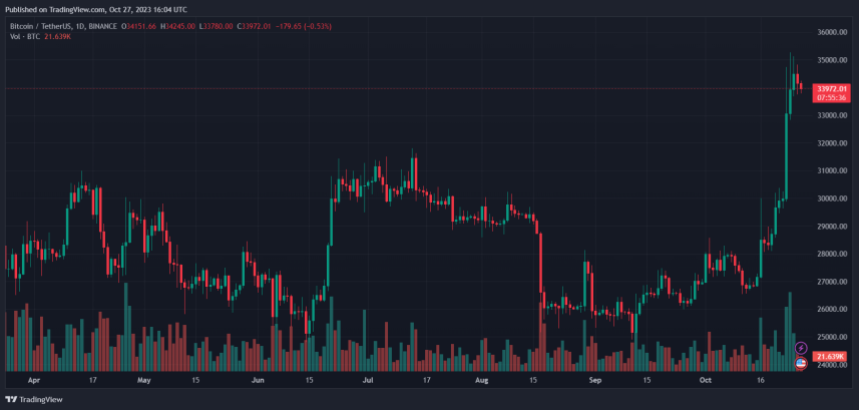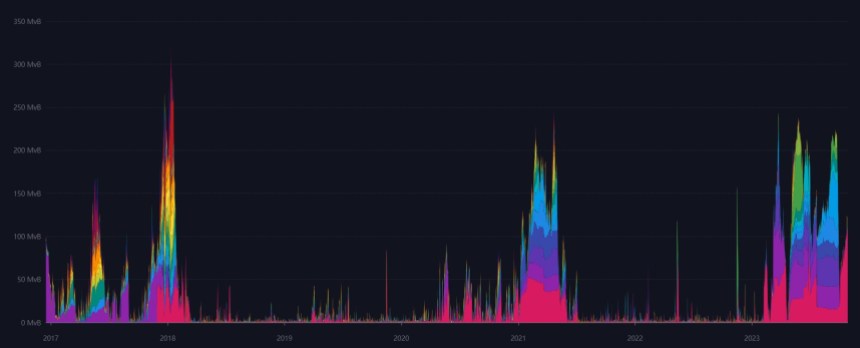The price of Bitcoin stands firm around the critical area of $34,000, hinting at further bullish potential. However, market analysts wonder if enough clues point to the upside or if BTC will return to $20,000.
As of this writing, BTC trades at $34,150 with sideways movement in the last 24 hours. The cryptocurrency recorded a 15% profit the previous week and remains a top coin performer by market cap.

Bitcoin On-Chain Activity Rises Hinting At A Bull Run?
Data from the analytics platform mempool.space shows an increase in on-chain activity on the Bitcoin network. This spike occurred in February 2023, when BTC transactions rose above 50 Mega Virtual bytes (MvB).
According to the analytics platform, the above metric measures the size of transactions and blocks on the BTC network. The larger the transaction, the more space they required.
As seen in the chart below, each time there is a rise in the price of BTC, there is a surge of activity leading to the rally. This happened in 2017, and 2021, and it is happening this year, which suggests the ecosystem is blooming, onboarding more users, and preparing for a more significant rally like in the previous year.

In addition to the increase in activity, it is possible to see the decline in the metric during the bear market and conclude bull markets record high activity. In contrast, the bear market records much less user activity, and they are generally cheaper to transact.
However, unlike 2017 and 2021, this year, this ecosystem saw the implementation of non-fungible tokens (NFTs) and new applications boosting these metrics. Thus, it is harder to determine if the current rally can reach similar levels than in previous years as the BTC DeFi ecosystem attracts more users looking to leverage the network for utility rather than long-term investing.
BTC DeFi Makes A Difference In Key BTC Metric? A Chat With The Team Behind “Leather”
The surge in BTC on-chain activity could be attributed to the cyclical nature of the crypto market. When the price of BTC and others rise, or there is an expectation of further profits, more users on-board the network.
As a result, the number of transactions recorded increases. However, many believe that with the implementation of NFTs in the BTC ecosystem, transaction activity can no longer be attributed to a new bullish cycle.
If so, rising activity metrics could become useless when measuring the sustainability of a BTC rally. To answer this question, we spoke with Mark Hendrickson, a General Manager at Trust Machines, a company working on a Bitcoin DeFi wallet. This is what he told us:
What is “Leather,” and what is your goal in the Bitcoin ecosystem?
A: Leather is a web3 wallets built around Bitcoin based technologies and applications. And so you can think of Leather, simply put as MetaMask for Bitcoin in the sense that we want to provide a robust user experience for connecting to applications built with Bitcoin and Bitcoin layers in which users can do a lot of the same sort of things that they can concurrently only do on smart contracts enabled L1 chains, but to do them actually on Bitcoin.
So, Leather has the ability to connect the applications, identify yourself to those applications based on your Bitcoin addresses and your associated assets with those applications prompts for signed transactions that are essentially actions for those applications and to do so across layers. (…) We also want to facilitate the movement of liquidity between L1 and L2 (networks) and do so in a very seamless manner.
A lot of people, for many reasons, are unfamiliar with the Bitcoin DeFi ecosystem. Can you tell us more about it, and what is Leather’s role in it? Also, what do you say to users who want Bitcoin to remain unchanged, the way it has been since its inception in 2009?
A: Bitcoin based DeFi, I’d say is generally taking place these days or sort of emerging in two places. You have primitives for Bitcoin based divide on Bitcoin itself. That’s an L1 (Layer one), mostly driven by Ordinals and within Ordinals fungible token standards like BRC 20. And then you have also Bitcoin related taking place on Layer2 like Stacks that have smart contract functionality. (…) most of that’s taking place via Ordinals on the layers. It’s taking place mostly through the native smart contracting capabilities of those layers.
To the question of people who want Bitcoin to remain unchanged, I think that the folks who are working on Bitcoin-related functionality, I’d say Bitcoin web3 in general, which includes DeFi. We’re trying actually to do more with Bitcoin without having to change Bitcoin really at all. So actually our general approach is to try to extend what you can do with Bitcoin without having to change it fundamentally because we do, of course, want to respect all the work that’s gone into Bitcoin to date and we’d love the security profile of Bitcoin. And that has to do with taking a relatively conservative approach. And so if you look at Ordinals, for example, which is really an innovation based on taproot introduced fairly recently, there’s a lot of innovation going on as a result of taproot ordinals without having really changed anything else about Bitcoin. It is a design space that is actually quite respectful of Bitcoin as blockchain.
There is a theory that every bull run is preceded by an increase in on-chain activity, with fees following prices on their way to new highs. What do you think of network activity right now? Do you think much of it can now be attributed to Ordinals and other applications?
A: Going back to the start of the year, Ordinals has been a huge exception to the general rule of the crypto bear market because we’ve experienced essentially two bull runs inside of Ordinals itself, which I think have boosted Bitcoin’s position and definitely has boosted network activity on Bitcoin and fee rates have gone up as a result of it. And really shown that this idea of storing data on chain on Bitcoin beyond just simple transactions and applying those primitives to various web3 applications, whether it’s art or whether it’s new token standards, that can have a huge effect on just how Bitcoin is used and also valued. (…) it’s hard for me to really pinpoint any given reason why any given month the Bitcoin may have gone up in price because of other factors, but it, it’s pretty clear that it has an overall effect (on network activity). Ordinals has been a positive influence on the interest in Bitcoin.
ETFs, store of value, Gold 2.0, Halving, and now Bitcoin DeFi, what is the current narrative dominating the BTC market? And which narrative will gain more prominence in the long run?
A: I think the dominant narrative around Bitcoin is probably that in the wake of the last crash, really it’s a spillover from last year. I think there are a lot of weaker technologies, weaker platforms and assets that were shaken out and people ran away from and they’ve taken more safe harbor and Bitcoin come back to Bitcoin as really the one that’s stood the test of time. So that combined with the fact that people, since the start of the year with Ordinals in particular have opened up to that there are more frontiers to what you can do with Bitcoin. I think that combination has really driven sort of a renewed enthusiasm around Bitcoin. It’s a combination of, it’s been around the longest, it’s the most secure, plus it’s not a dinosaur that can’t evolve still. It actually has a lot of potential. It actually has both of those qualities that are very attractive, secure and conservative in one way, but it’s also more innovative and there’s more potential than people had realized before on the other hand.
Cover image from Unsplash, chart from Tradingview
















